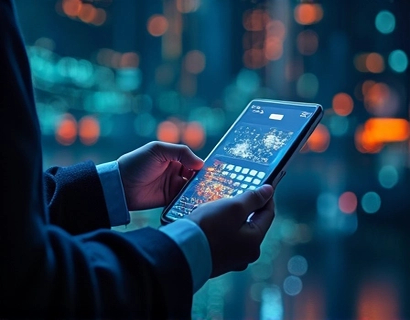Unlocking Accessibility: Exploring the Best Universal Apps for Enhanced Productivity and Creativity
In an era where technology plays a pivotal role in our daily lives, the importance of accessibility cannot be overstated. Universal apps, designed to be usable by everyone, regardless of their abilities, are revolutionizing the way we interact with digital devices. These applications bridge the gap between users with diverse needs and the vast potential of modern technology, fostering an inclusive environment where productivity and creativity know no bounds. This article delves into the world of universal applications, highlighting the most innovative tools that transform the way we work, create, and connect.
The concept of universal design in technology is rooted in the belief that products and environments should be usable by all people, to the greatest extent possible, without the need for adaptation or specialized design. In the digital realm, this translates to apps that are intuitive, flexible, and adaptable to various user requirements. Whether it's visual, auditory, motor, or cognitive impairments, universal apps aim to provide equal access and opportunities for everyone.
Understanding Universal App Design
Universal app design is not just about compliance with accessibility standards; it's about creating experiences that are inherently inclusive. This approach involves considering a wide range of user abilities and preferences from the outset, rather than as an afterthought. Key principles include simplicity and intuitiveness, flexibility in use, perceptibility of information, and tolerance for error.
Simplicity and intuitiveness ensure that apps are easy to understand and use, regardless of the user's experience level. Flexibility in use allows users to adapt the app to their individual needs, whether through customizable settings or multiple interaction methods. Perceptibility of information ensures that all necessary data is presented in a way that is accessible to users with different sensory abilities. Tolerance for error minimizes the consequences of accidental actions, making the app safer and more forgiving.
Enhanced Productivity through Universal Apps
Productivity apps are the backbone of modern workflows, and universal design enhances their effectiveness for all users. One standout app in this category is Microsoft Office Accessibility Features. Integrated into the popular Office suite, these features include Narrator, a built-in screen reader, and the Magnifier, which enlarges parts of the screen. For users with visual impairments, these tools ensure that they can access and manipulate documents, spreadsheets, and presentations with ease.
Another exemplary app is Voice Dream Writer. This text-to-speech app transforms the way users create and edit text. With its advanced speech engine and customizable settings, it caters to users with dyslexia, visual impairments, and those who prefer auditory processing. The app's ability to read aloud text, correct spelling and grammar, and support multiple file formats makes it an indispensable tool for enhancing productivity.
Boosting Creativity with Universal Apps
Creativity knows no bounds, and universal apps are expanding the horizons for artists, writers, and designers alike. Procreate, a digital painting app, stands out for its accessibility features. It offers a range of customizable brushes, a robust color picker, and the ability to use external keyboards and switches. For users with motor impairments, the app's support for alternative input methods ensures that the creative process is uninterrupted.
Adobe Fresco is another powerful tool that combines traditional and digital art techniques. It includes features like Live Brushes, which simulate real-world painting and drawing, and the ability to use stylus pressure for varying line thickness and opacity. The app's accessibility settings, such as adjustable brush sizes and customizable gestures, make it accessible to a wide range of users, from beginners to professionals.
Communication and Collaboration Tools
Effective communication and collaboration are essential in any productive environment. Universal apps in this domain ensure that everyone can participate fully. Microsoft Teams is a comprehensive platform that integrates chat, video meetings, and file sharing. Its accessibility features include closed captioning for meetings, screen reader support, and customizable text sizes. For users with hearing impairments, the real-time transcription service is a game-changer, ensuring that all team members can engage equally.
Slack, another popular communication tool, offers a range of accessibility features. These include screen reader compatibility, high-contrast mode, and the ability to customize keyboard shortcuts. The app's focus on flexibility and adaptability makes it a valuable asset for teams striving to be inclusive and productive.
Education and Learning Apps
The educational sector has greatly benefited from universal app design, making learning more accessible and engaging. Khan Academy is a leading platform for free online education, offering a wide range of subjects from math and science to art and humanities. The app is designed with accessibility in mind, featuring text-to-speech, adjustable text sizes, and compatibility with screen readers. This ensures that students with various needs can access high-quality educational content.
Speech Central is another excellent app for learners. It converts web pages, documents, and eBooks into spoken words, making reading easier for users with dyslexia or visual impairments. The app supports multiple languages and can read aloud web articles, PDFs, and eBooks, providing a versatile tool for enhancing learning experiences.
Everyday Productivity and Utility Apps
Beyond specialized apps, universal design is also transforming everyday utility tools. Google Assistant and Amazon Alexa are voice-activated assistants that simplify tasks and manage daily routines. These apps are designed to be accessible, allowing users to control smart home devices, set reminders, and access information hands-free. For users with mobility or dexterity impairments, voice commands provide a powerful means of interaction.
Notability is a note-taking app that excels in accessibility. It supports multiple input methods, including handwriting, typing, and voice dictation. The app's ability to sync across devices ensures that notes are always accessible, and its compatibility with screen readers makes it a valuable tool for students and professionals alike.
Conclusion
The future of technology is inherently inclusive, and universal apps are leading the charge. By prioritizing accessibility, these applications not only enhance productivity and creativity but also foster a more equitable digital world. As tech enthusiasts and innovators, embracing universal design principles is crucial for creating solutions that benefit everyone. The apps highlighted in this article are just a glimpse into the vast array of tools available, each contributing to a more accessible and connected future.











































